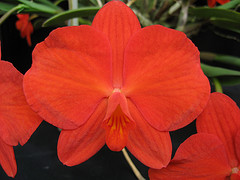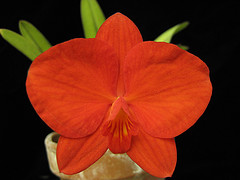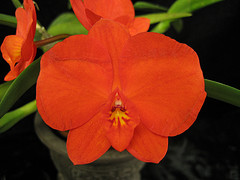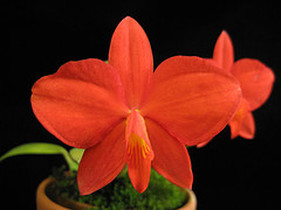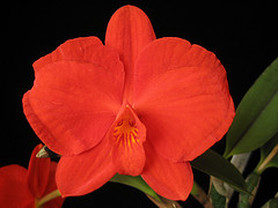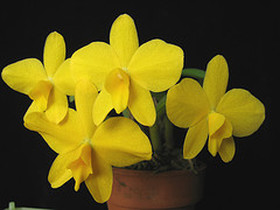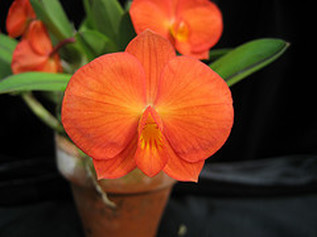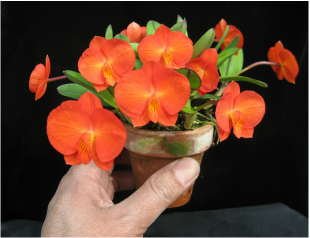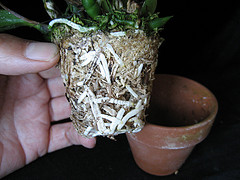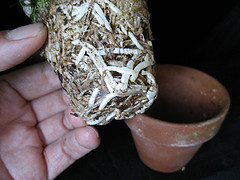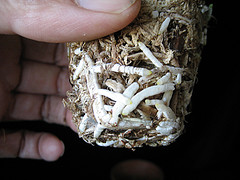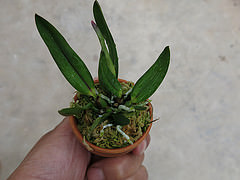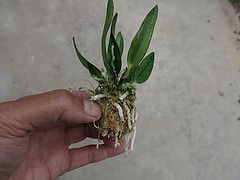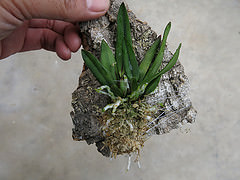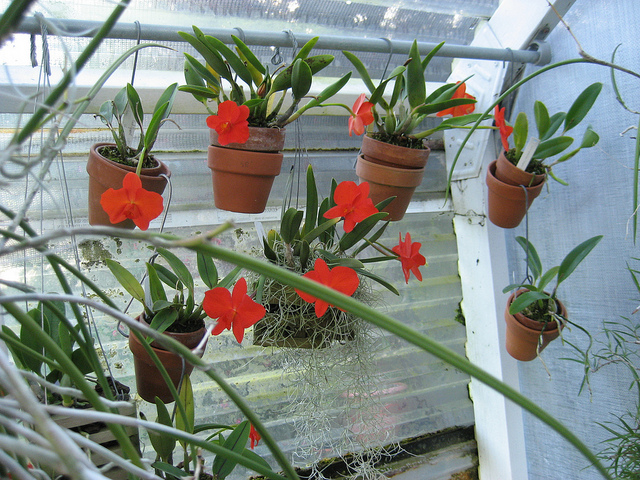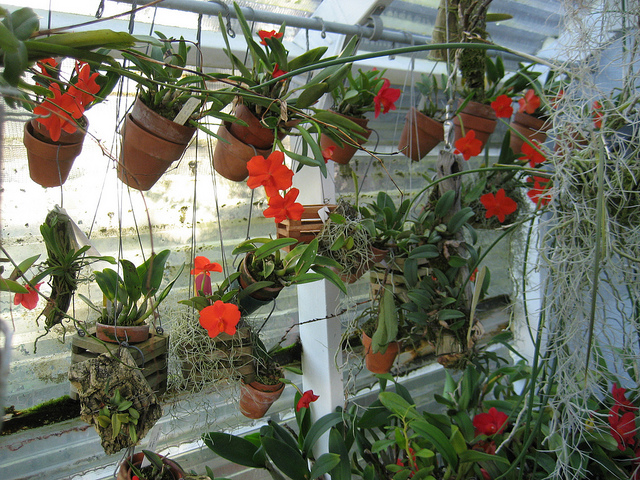Cattleya coccinea
is a charming miniature species known for its brilliant orange red
flowers. It is native to tropical
mountain rainforests in Brazil, growing as epiphytes on trees at an elevation
of 2,800-5,500 feet (855 to 1,675 m).
The climate is cool and bright, with temperatures sometimes reaching the
80’s (27C), with a dip in winter into the high 30’s (3C). Humidity is high throughout the day with fog
often at night.
The plants are very small with pseudobulbs and leaves at 3-4” (7.5-10cm). The leaves usually have a dark maroon stripe along the midrib. Plants can break multiple leads from the newest bulbs, and can form fairly large clumps. New roots tend to form just once a year, usually in the fall. Most have a single bloom per inflorescence but some may have 2 flowers. Flowers range from orange red to dark red, and have a natural spread of 2” (5cm). Through line breeding and the introduction of tetraploid forms, there are now flowers reaching over 3-3.5” (7.5-8.8cm) across! Flowers last 6-8 weeks in bloom, and have a wonderful crystalline texture that sparkles in sunlight. Unlike other members of the Cattleya family, they are not fragrant.
The plants are very small with pseudobulbs and leaves at 3-4” (7.5-10cm). The leaves usually have a dark maroon stripe along the midrib. Plants can break multiple leads from the newest bulbs, and can form fairly large clumps. New roots tend to form just once a year, usually in the fall. Most have a single bloom per inflorescence but some may have 2 flowers. Flowers range from orange red to dark red, and have a natural spread of 2” (5cm). Through line breeding and the introduction of tetraploid forms, there are now flowers reaching over 3-3.5” (7.5-8.8cm) across! Flowers last 6-8 weeks in bloom, and have a wonderful crystalline texture that sparkles in sunlight. Unlike other members of the Cattleya family, they are not fragrant.
Tetraploids
Most plants of C. coccinea grown in cultivation are tetraploids (4n) and triploids (3n). These polyploid forms usually have larger leaves and flowers, some with outstanding full form. Tetraploids have been used extensively in breeding miniature and compact cattleya hybrids. Some of the best strains of coccineas are coming out of Japan, where they have been line bred for years. I have found that tetraploid strains are sturdier, more vigorous growing plants. They are often more tolerant of warmer temperatures than the diploid forms.
Most plants of C. coccinea grown in cultivation are tetraploids (4n) and triploids (3n). These polyploid forms usually have larger leaves and flowers, some with outstanding full form. Tetraploids have been used extensively in breeding miniature and compact cattleya hybrids. Some of the best strains of coccineas are coming out of Japan, where they have been line bred for years. I have found that tetraploid strains are sturdier, more vigorous growing plants. They are often more tolerant of warmer temperatures than the diploid forms.
Aurea Forms
The yellow form is still quite rare in cultivation and extremely desirable. Plants seem to be even more finicky than the type form. The leaves are a light green and do not have the maroon stripe along the midrib. Flower shape is a bit open, about 2” (5cm) across, and color is the most brilliant yellow. Due to the rarity of this form, they have not been line bred and have not reached the superior size and shape of the type form. As far as I know, there are currently no tetraploid yellow forms.
The yellow form is still quite rare in cultivation and extremely desirable. Plants seem to be even more finicky than the type form. The leaves are a light green and do not have the maroon stripe along the midrib. Flower shape is a bit open, about 2” (5cm) across, and color is the most brilliant yellow. Due to the rarity of this form, they have not been line bred and have not reached the superior size and shape of the type form. As far as I know, there are currently no tetraploid yellow forms.
New Miniature Forms
This form is even smaller than the type form. Plants are about 3” (7.5cm) tall, and the flowers are under 2”(5cm) wide. The flowers are very full with round overlapping petals. I find this form especially appealing. Plants break new leads readily and can be quite showy in bloom. I found this form a few years ago at the Japan Grand Prix. I currently have a sibling cross of my two best varieties and hope to introduce these plants in a few years.
This form is even smaller than the type form. Plants are about 3” (7.5cm) tall, and the flowers are under 2”(5cm) wide. The flowers are very full with round overlapping petals. I find this form especially appealing. Plants break new leads readily and can be quite showy in bloom. I found this form a few years ago at the Japan Grand Prix. I currently have a sibling cross of my two best varieties and hope to introduce these plants in a few years.
Cultivation
C. coccinea has long had the reputation of being difficult to grow. In some aspects, after growing them for over 8 years, I have to agree. There are a few particular factors that need to be taken into account. The most important factor in growing a healthy plant is to have healthy roots. Starting with a vigorous, well rooted plant is a definite plus. A plant that has lost its roots can be very challenging to bring back to health. Often the plant will sulk for many months before finally dropping its leaves and dying. Be prepared to give them fairly constant attention. These are not plants that you can leave on vacation for weeks and expect to return with happy healthy plants. Although this plant requires some care, there is something about mastering the cultivation of a difficult species, and the gratifying reward in flowering the plant!
Growing Methods
There are several ways to grow C. coccinea. The best method may depend on your growing conditions.
For areas that are on the warm and dry side, it is best to grow in pots. I recommend small clay pots and New Zealand sphagnum moss. It is critical to the health of the roots not to over pot as the center of the moss may stay too wet. Before potting, make sure to enlarge the drainage hole by using a pair of pliers and to gently tap at the hole. Start off gently as too much force will crack the pot! Packing the moss around the roots and into the pot takes a little bit of practice. I can best describe it as a “firm” packing, not too tight and not too loose. If the moss is too tight, it will be difficult to rewet if the moss becomes dry; if too loose then the moss tends to hold too much water. A good test of the correct packing of moss is to pick up the plant by the bulbs; the pot and moss ball should not fall off. Leave some space at the top of the pot so that water can pool slightly, as the moss may be difficult to wet when dry. Also leave some air space at the bottom of the pot so that there is plenty of air circulation. It is extremely important that the moss be replaced annually in the fall. Plant roots will not tolerate stale medium.
C. coccinea has long had the reputation of being difficult to grow. In some aspects, after growing them for over 8 years, I have to agree. There are a few particular factors that need to be taken into account. The most important factor in growing a healthy plant is to have healthy roots. Starting with a vigorous, well rooted plant is a definite plus. A plant that has lost its roots can be very challenging to bring back to health. Often the plant will sulk for many months before finally dropping its leaves and dying. Be prepared to give them fairly constant attention. These are not plants that you can leave on vacation for weeks and expect to return with happy healthy plants. Although this plant requires some care, there is something about mastering the cultivation of a difficult species, and the gratifying reward in flowering the plant!
Growing Methods
There are several ways to grow C. coccinea. The best method may depend on your growing conditions.
For areas that are on the warm and dry side, it is best to grow in pots. I recommend small clay pots and New Zealand sphagnum moss. It is critical to the health of the roots not to over pot as the center of the moss may stay too wet. Before potting, make sure to enlarge the drainage hole by using a pair of pliers and to gently tap at the hole. Start off gently as too much force will crack the pot! Packing the moss around the roots and into the pot takes a little bit of practice. I can best describe it as a “firm” packing, not too tight and not too loose. If the moss is too tight, it will be difficult to rewet if the moss becomes dry; if too loose then the moss tends to hold too much water. A good test of the correct packing of moss is to pick up the plant by the bulbs; the pot and moss ball should not fall off. Leave some space at the top of the pot so that water can pool slightly, as the moss may be difficult to wet when dry. Also leave some air space at the bottom of the pot so that there is plenty of air circulation. It is extremely important that the moss be replaced annually in the fall. Plant roots will not tolerate stale medium.
This is what you want to see on a healthy plant - lots of live roots!
Other ways to grow C.
coccinea are either mounted or in a small wood slat basket. In both cases it is best to use little or no
sphagnum moss around the roots. I find after
a few months the moss either dries out or stays too wet for the roots. The challenge is to get the plants to root to
the mount or basket. To insure success, start with a well rooted plant. Once the roots establish on the mount, the plants seem to grow readily. The best time to mount your plants is in the
fall when you see new roots forming.
Providing constant high relative humidity of 60-70% is important for
mounted plants.
Example of a seedling ready to be mounted. Note the active roots! Remove some moss before mounting.
My best growing plants are hanging in the greenhouse. They seemed to appreciate the gentle air movement by being off the bench. They also receive more light. They do seem to dry out faster than the ones on the bench, so check them often.
Water
Since the roots are very sensitive it is important to use water that is low in dissolved salts. I recommend rain, distilled, or reverse osmosis treated water. For mounted plants, mist the plants daily or every other day in very humid conditions. Since plants in nature are subjected to nightly fog, it is fine to water in the afternoon or early evening. For potted plants, knowing when to water is more challenging. Plants in moss should be just barely moist before watering again. If you have algae or green moss growing on top of your moss, you are probably keeping it too wet. In the heat of summer it is best to keep plants on the dry side. The best sign of proper watering is to see plenty of new active roots in the moss.
Fertilizer
Fertilize very lightly when plants are in active growth. Use a fertilizer formulated for pure water. If fertilizing plants in moss, it is important to flush the pot heavily with water once a month. If you regularly fertilize plants potted in moss, you may need to change the moss more than once a year.
Light
Plants need bright filtered sunlight. If your growing area is in full sun, 70% shade cloth would provide the right amount of light. A range of 2500 -3000 footcandles would be about right. If temperatures reach 90 (32C) plus degrees, it is best to provide more shade. Leaves should be a medium green color.
Temperature
Ideal daytime temperature is 70-80 (21-27C) degrees. Plants can tolerate temperatures over 90 (32C) degrees for short periods, however for extended periods of heat, they will experience some stress. Plants appreciate a dip into the 60’s (16C) or below at night. I have found plants will be fine with winter night temperatures into the mid 30’s (2C). In order to bloom plants well, it is important to have a day/night differential.
Humidity
Provide 60-70% relative humidity all year if plants are mounted or when roots are exposed. If potted, plants can tolerate lower humidity levels. With high humidity, gentle air movement around plants is recommended.
Pests and Disease
Fortunately healthy plants do not seem to be prone to insects or disease. Occasionally you might find scale or mealybugs on your plants. Since the plants are small and the bulbs grow close together, it is important to check your plants often for signs of pests and disease. Occasionally new growths will rot and turn black. This is not usually a problem as dormant eyes will soon sprout. Keep a watch out for snails and slugs, which find the new root tips and buds tasty! This includes the hard to control tiny bush snails.
Repotting and Dividing
Potted plants should be repotted once a year in the fall. I usually only change the moss and the plant can go back into the same clay pot. If you wish to divide your plants, keep the divisions with at least 5 bulbs or more. Each division should have at least a few healthy roots. Again it is important not to over pot; keep them in as small a pot as possible. If you have divisions, this is usually a good time to experiment with mounting plants.
Since the roots are very sensitive it is important to use water that is low in dissolved salts. I recommend rain, distilled, or reverse osmosis treated water. For mounted plants, mist the plants daily or every other day in very humid conditions. Since plants in nature are subjected to nightly fog, it is fine to water in the afternoon or early evening. For potted plants, knowing when to water is more challenging. Plants in moss should be just barely moist before watering again. If you have algae or green moss growing on top of your moss, you are probably keeping it too wet. In the heat of summer it is best to keep plants on the dry side. The best sign of proper watering is to see plenty of new active roots in the moss.
Fertilizer
Fertilize very lightly when plants are in active growth. Use a fertilizer formulated for pure water. If fertilizing plants in moss, it is important to flush the pot heavily with water once a month. If you regularly fertilize plants potted in moss, you may need to change the moss more than once a year.
Light
Plants need bright filtered sunlight. If your growing area is in full sun, 70% shade cloth would provide the right amount of light. A range of 2500 -3000 footcandles would be about right. If temperatures reach 90 (32C) plus degrees, it is best to provide more shade. Leaves should be a medium green color.
Temperature
Ideal daytime temperature is 70-80 (21-27C) degrees. Plants can tolerate temperatures over 90 (32C) degrees for short periods, however for extended periods of heat, they will experience some stress. Plants appreciate a dip into the 60’s (16C) or below at night. I have found plants will be fine with winter night temperatures into the mid 30’s (2C). In order to bloom plants well, it is important to have a day/night differential.
Humidity
Provide 60-70% relative humidity all year if plants are mounted or when roots are exposed. If potted, plants can tolerate lower humidity levels. With high humidity, gentle air movement around plants is recommended.
Pests and Disease
Fortunately healthy plants do not seem to be prone to insects or disease. Occasionally you might find scale or mealybugs on your plants. Since the plants are small and the bulbs grow close together, it is important to check your plants often for signs of pests and disease. Occasionally new growths will rot and turn black. This is not usually a problem as dormant eyes will soon sprout. Keep a watch out for snails and slugs, which find the new root tips and buds tasty! This includes the hard to control tiny bush snails.
Repotting and Dividing
Potted plants should be repotted once a year in the fall. I usually only change the moss and the plant can go back into the same clay pot. If you wish to divide your plants, keep the divisions with at least 5 bulbs or more. Each division should have at least a few healthy roots. Again it is important not to over pot; keep them in as small a pot as possible. If you have divisions, this is usually a good time to experiment with mounting plants.

